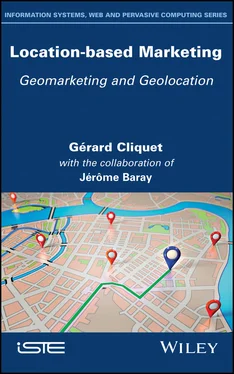– strategic marketing and marketing management.
Introducing space in these areas involves many changes, sometimes even upheavals, because it is now a question of thinking and acting differently.
1.2.3.3.1. The consumer’s spatial behavior
Consumer behavior can no longer be considered in the same way once space is taken into account. Too little marketing research has considered this spatial dimension in consumer behavior and this requires a revisit to geography (Golledge and Stimson 1997; Golledge 1999).
A few articles have been able to advance knowledge in this area. Work based on reference dependence theory (Tversky and Kahneman 1991; Tversky and Simonson 1993) has led to a better understanding of consumer shopping trips (Brooks et al . 2004; Brewer 2007) (see Chapter 2).
Older work has been carried out on the basis of gravity and/or spatial interaction models (Reilly 1931; Huff 1964; Nakanishi and Cooper 1974).
Increased consumer mobility, their ability to use so-called mobile technologies (smartphones and tablets) and changes in retail offers, physical or virtual stores on the Internet, are accelerating ubiquitous purchasing processes. This evolution makes gravity-based models less efficient even if they are far from useless, if only in the definition of certain geofencing applications, that is, the determination of the attraction or trading area. This technique is described as an extreme form of marketing location and is increasingly used to send promotional offers in the form of coupons to consumers who are either in the store or near the point of sale using SMS on their smartphone (Mattioli and Bustillo 2012). In other words, the issue here is how far away should current or potential customers of promotional offers be alerted, on their smartphone or tablet, when they pass “near” the store or more generally on opportunities that may interest them. Chapter 5will deal with geofencing.
Consumers are increasingly capable of mobility without it increasing overall: retailers and traders must adapt to it (Vizard 2013). Sometimes it is quite easy. For example, a distributor near the Massachusetts-New Hampshire border found that residents of New Hampshire may not pay the vehicle taxes required in Massachusetts (Banos et al . 2015). He therefore placed an order with a company specializing in geofencing to include all potential customers in New Hampshire in his database. But this is again a gravity-type attraction (Reilly 1931; Huff 1964; Cliquet 1988).
When we want to attract customers who pass near a point of sale, otherwise known as taking advantage of the flows of the temporary attraction (Cliquet 1997a), the operation is more delicate. Indeed, how can this proximity be evaluated? This concept of proximity has become central to the thinking of major retailers, for example. For many years now, people have been wondering about the future of these “shoe boxes”, known as hypermarkets, a store format invented in France in 1963 by Carrefour and copied in many countries, including the United States in the 1990s (Europe can also sometimes be a little ahead). But hypermarkets are increasingly neglected, especially the largest ones, because they no longer meet the needs of customers seeking both purchasing power and another way of life that is less consumer-oriented. Will smartphones and geo-fencing (Streed et al . 2013) be able to save them?
1.2.3.3.2. Spatial marketing studies
The introduction of space in marketing studies implies taking distance into account. Just because we regularly talk about the digital economy, which no longer has a border, does not mean that there is no longer any distance or that everything has been globalized, thus eliminating any local specificity. On the contrary, we are witnessing a real resurgence of the local.
On a more methodological level, distance is a complex variable. A distinction is made between geographical distance and temporal distance: the law of gravity of retail trade uses geographical distance when Huff’s model favors temporal distance. However, the geographical distance is difficult to manipulate. Purely metric distance is only rarely considered, especially in the behavior of out-of-store consumers. Since they travel with their vehicles, or by public transport, the temporal distance (Brunner and Mason 1968) is preferred by researchers and analysts. But it is no more satisfactory, because consumers, like all decision-makers, make their decisions not according to reality, but according to their perception of it. This can probably be partly attributed to bounded rationality (Simon 1955). Under these conditions, the perceived distance should be preferred despite methodological problems (Cliquet 1990, 1995).
With regard to internationalization, companies are not immune to problems related to culture, among other things. The so-called Uppsala model (Johanson and Wiedersheim-Paul 1975) underlines the influence of psychological distance to explain the difficulties of export companies. This psychological distance is broken down into geographical, economic, cultural and institutional distances (see Chapter 2).
1.2.3.3.3. Strategy and spatial marketing
Once potential targets have been identified by the spatial study of behavior, the marketing strategy can be defined. Taking the environment into account can lead to the dilemma already mentioned: local versus global. This contextualization can be troublesome, and has been for a long time, because it can lead to conflicting options that can damage the brand image. However, digital mobility tools can partly solve this dilemma by improving customer contact. This evolution implies a better consideration of the link between production and distribution, in other words, logistics. In order to solve the problem of the optimal compromise between quality and cost (and therefore price), effective coordination becomes essential, and only flawless logistics can make this possible. However, logistics also has a cost, and reducing it requires a rigorous control of space by controlling the distribution of products and therefore thanks to a good spatial distribution of sales outlets. We will see that this spatial dissemination of customer contact points implies a different way of thinking about the spatial strategies for setting up sales units, stores, restaurants, hotels, etc., through, for example, the application of percolation theory (Cliquet and Guillo 2013).
This problem of spatial coverage of point of sale networks does not only affect retailing. It is also of interest to manufacturers; some of them have found that traditional media no longer allow contact with the consumer as effectively as before. As the American firm Procter & Gamble has found, individuals now have technical possibilities to bypass advertising on their TV sets or to avoid spam in their mailboxes (Arzoumanian 2005). However, points of sale are now a safer medium: in 2005, Procter & Gamble observed that in the United States, 100,000,000 customers visited Walmart stores every week, 22,000,000 visited Home Depot stores and 42,000,000 visited 7-Eleven convenience stores. Under these conditions, the best located chains are better media than TV or Internet advertising. Moreover, Zara, the Spanish clothing company, has never advertized in the traditional sense and uses its own stores as promotional media. Procter & Gamble had even thought of launching its own chain of stores selling all the company's products, but had to give it up: P&G is primarily a manufacturing company, and retailing is a quite different job.
1.2.3.3.4. Spatial marketing management
The marketing strategy must then be implemented by a marketing management team that also includes the introduction of space into operational decisions. This marketing management involves the definition of a marketing mix that refers to the 4Ps (McCarthy 1960) for Product, Price, Place and Promotion. Chapter 3of this book shows that the 4P “rule” has been challenged (Van Watershoot and Van der Bulte 1992), and that it is possible to “geolocate” the elements of the marketing mix.
Читать дальше












